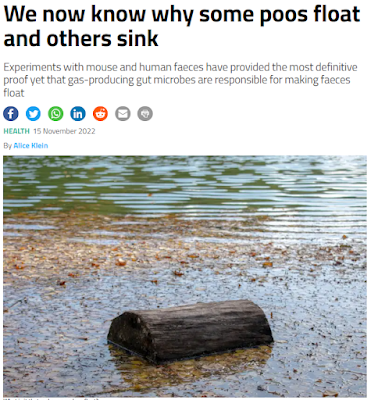Giờ thì em đã hiểu
cứt nổi hay chìm là do vi khuẩn trong ruột và lượng khí chúng tạo ra... :D
-----
About 10 to 15 per cent of people consistently do poos that float in toilet water – so-called “floaters”, while the rest typically produce poos that sink to the bottom, or “sinkers”.
In 1972, Michael Levitt, a gastroenterologist (người nghiên cứu dạ dày-ruột) at University of Minnesota Hospitals, and his student William Duane showed this was largely to do with the gas content of faeces (phân), not fat content, as was previously assumed. They collected floaters from 13 people and found they all sank when the gas inside was removed by increased pressurisation, even if they had high fat content.
Their research was prompted by Duane revealing to Levitt that his poos always floated. “About 2 hours after our discussion, he passed a stool, we put it in a flask, pressurised the flask and watched the stool sink, demonstrating the stool floated because of its gas content,” says Levitt.
Levitt and Duane believed this gas must have come from gut bacteria that became incorporated in the faeces, because two floaters they tested contained high levels of methane gas, which is made by bacteria that ferment carbohydrates as they pass through the large intestine. However, they couldn’t tell for sure.
Now, Nagarajan Kannan at the Mayo Clinic in Rochester, Minnesota, and his colleagues have confirmed this hunch after noticing that mice bred so they don’t have any gut bacteria – known as germ-free mice – always produce sinkers, whereas nearly half of standard mice produce floaters.
Bài trước: Còn sớm hơn thế
Tags: science



Post a Comment